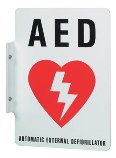
Poll Finds Many Misunderstand SCA and AEDs
The Heart Rhythm Society conducted the national survey in conjunction with Sudden Cardiac Arrest Awareness Month in October. HRS says more education and research are needed to increase public knowledge.
A national poll conducted by the Heart Rhythm Society found nearly 40 percent of respondents didn't realize most people who die from sudden cardiac arrest have no outward warning signs, and only one-third of respondents knew SCA victims need CPR or a shock from an automated external defibrillator within 4-6 minutes to have a chance of surviving. The society (www.hrsonline.org), nearing the 30th anniversary of its founding and now consisting of more than 4,900 heart rhythm professionals around the world, also said nearly 60 percent of respondents didn't know implantable cardioverter defibrillators (ICDs) are the most effective treatment to protect those at risk of SCA.
The society conducted the poll in conjunction with this month's first-ever congressionally designated Sudden Cardiac Arrest Awareness Month. HRS said the results show more public education, more research, and greater access to SCA treatments are needed.
"SCA Awareness Month provides us the opportunity to draw attention to and build awareness around one of the leading causes of death in our country -- and one that the public, unfortunately, knows very little about," said HRS President Dr. N.A. Mark Estes. "The Heart Rhythm Society is working to raise awareness about the risk of SCA, improve the public's ability to identify warning signs, encourage individuals to seek medical attention in a timely manner, and promote the need for further research into the causes of this leading killer."
The survey indicated 75 percent of respondents have concerns about using an AED, specifically, not knowing how to use one, hurting the victim, shocking a victim who doesn't need a shock, and shocking or hurting oneself while treating the victim. All of these fears are unfounded, resuscitation experts say.
Congress last month passed resolutions designating October as Sudden Cardiac Arrest Awareness Month.